
VSP-LLM
None
Stars: 275
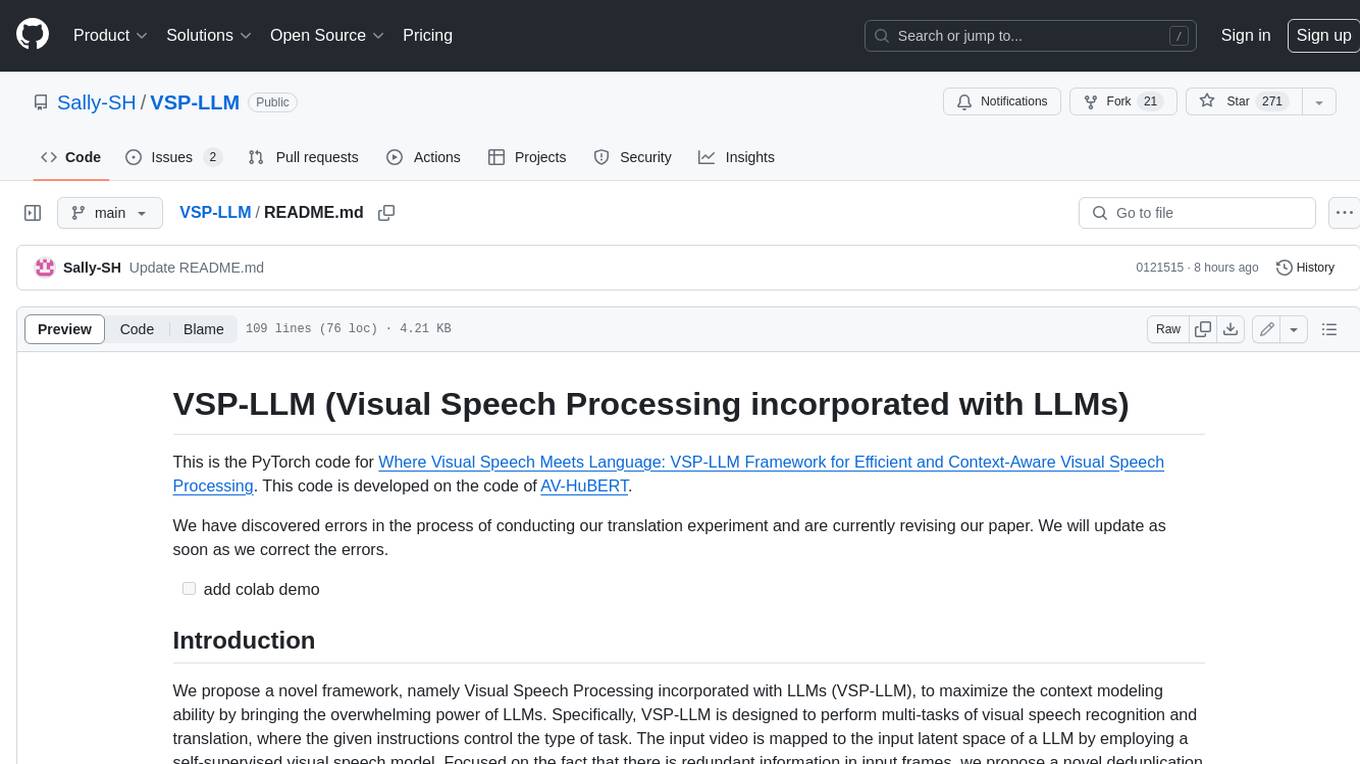
VSP-LLM (Visual Speech Processing incorporated with LLMs) is a novel framework that maximizes context modeling ability by leveraging the power of LLMs. It performs multi-tasks of visual speech recognition and translation, where given instructions control the task type. The input video is mapped to the input latent space of a LLM using a self-supervised visual speech model. To address redundant information in input frames, a deduplication method is employed using visual speech units. VSP-LLM utilizes Low Rank Adaptors (LoRA) for computationally efficient training.
README:
This is the PyTorch code for Where Visual Speech Meets Language: VSP-LLM Framework for Efficient and Context-Aware Visual Speech Processing. This code is developed on the code of AV-HuBERT.
We propose a novel framework, namely Visual Speech Processing incorporated with LLMs (VSP-LLM), to maximize the context modeling ability by bringing the overwhelming power of LLMs. Specifically, VSP-LLM is designed to perform multi-tasks of visual speech recognition and translation, where the given instructions control the type of task. The input video is mapped to the input latent space of a LLM by employing a self-supervised visual speech model. Focused on the fact that there is redundant information in input frames, we propose a novel deduplication method that reduces the embedded visual features by employing visual speech units. Through the proposed deduplication and Low Rank Adaptors (LoRA), VSP-LLM can be trained in a computationally efficient manner.
You can find checkpoint of our model in here.
Move the checkpoint to checkpoints.
conda create -n vsp-llm python=3.9 -y
conda activate vsp-llm
git clone https://github.com/Sally-SH/VSP-LLM.git
cd VSP-LLM
pip install -r requirements.txt
cd fairseq
pip install --editable ./
- Download AV-HuBERT pre-trained model
AV-HuBERT Large (LSR3 + VoxCeleb2)from here. - Download LLaMA2-7B from here.
Move the AV-HuBERT pre-trained model checkpoint and the LLaMA2-7B checkpoint to checkpoints.
Follow Auto-AVSR preparation to preprocess the LRS3 dataset.
Then, follow AV-HuBERT preparation from step 3 to create manifest of LRS3 dataset.
Follow the steps in clustering to create:
-
{train,valid}.kmframe-aligned pseudo label files. Thelabel_rateis the same as the feature frame rate used for clustering, which is 25Hz for AV-HuBERT features by default.
.
├── lrs3
│ ├── lrs3_video_seg24s # Preprocessed video and audio data
│ └── lrs3_text_seg24s # Preprocessed text data
├── muavic_dataset # Mix of VSR data and VST(En-X) data
│ ├── train.tsv # List of audio and video path for training
│ ├── train.wrd # List of target label for training
│ ├── train.cluster_counts # List of clusters to deduplicate speech units in training
│ ├── test.tsv # List of audio and video path for testing
│ ├── test.wrd # List of target label for testing
│ └── test.cluster_counts # List of clusters to deduplicate speech units in testing
└── test_data
├── vsr
│ └── en
│ ├── test.tsv
│ ├── test.wrd
│ └── test.cluster_counts
└── vst
└── en
├── es
: ├── test.tsv
: ├── test.wrd
: └── test.cluster_counts
└── pt
├── test.tsv
├── test.wrd
└── test.cluster_counts
The test manifest is provided in labels. You need to replace the path of the LRS3 in the manifest file with your preprocessed LRS3 dataset path using the following command:
cd src/dataset
python replace_path.py --lrs3 /path/to/lrs3Then modified test amanifest is saved in dataset
Open the training script (scripts/train.sh) and replace these variables:
# path to train dataset dir
DATA_PATH=???
# path where output trained models will be located
OUT_PATH=???Run the training script:
$ bash scripts/train.shOpen the decoding script (scripts/decode.sh) and replace these variables:
# language direction (e.g 'en' for VSR task / 'en-es' for En to Es VST task)
LANG=???
# path to the trained model
MODEL_PATH=???
# path where decoding results and scores will be located
OUT_PATH=???Run the decoding script:
$ bash scripts/decode.shFor Tasks:
Click tags to check more tools for each tasksFor Jobs:
Alternative AI tools for VSP-LLM
Similar Open Source Tools

VSP-LLM
VSP-LLM (Visual Speech Processing incorporated with LLMs) is a novel framework that maximizes context modeling ability by leveraging the power of LLMs. It performs multi-tasks of visual speech recognition and translation, where given instructions control the task type. The input video is mapped to the input latent space of a LLM using a self-supervised visual speech model. To address redundant information in input frames, a deduplication method is employed using visual speech units. VSP-LLM utilizes Low Rank Adaptors (LoRA) for computationally efficient training.
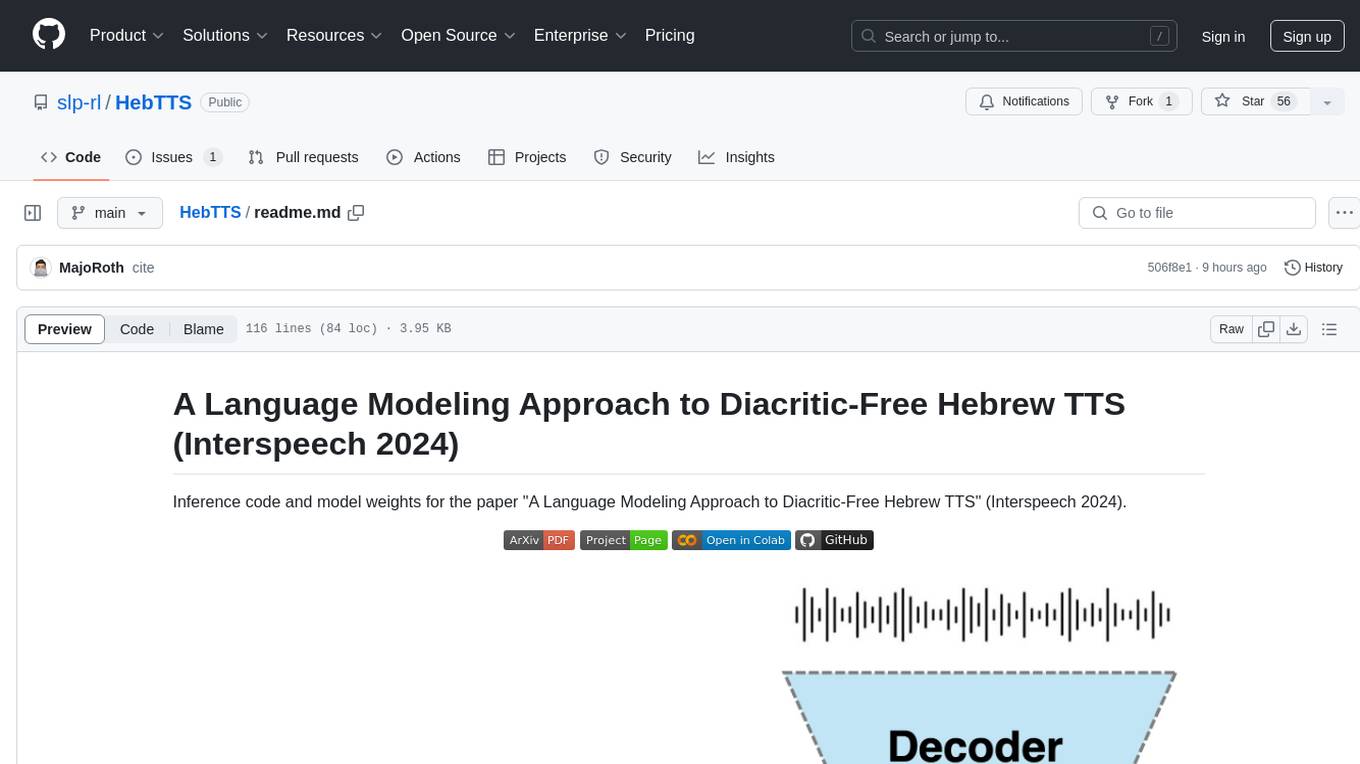
HebTTS
HebTTS is a language modeling approach to diacritic-free Hebrew text-to-speech (TTS) system. It addresses the challenge of accurately mapping text to speech in Hebrew by proposing a language model that operates on discrete speech representations and is conditioned on a word-piece tokenizer. The system is optimized using weakly supervised recordings and outperforms diacritic-based Hebrew TTS systems in terms of content preservation and naturalness of generated speech.
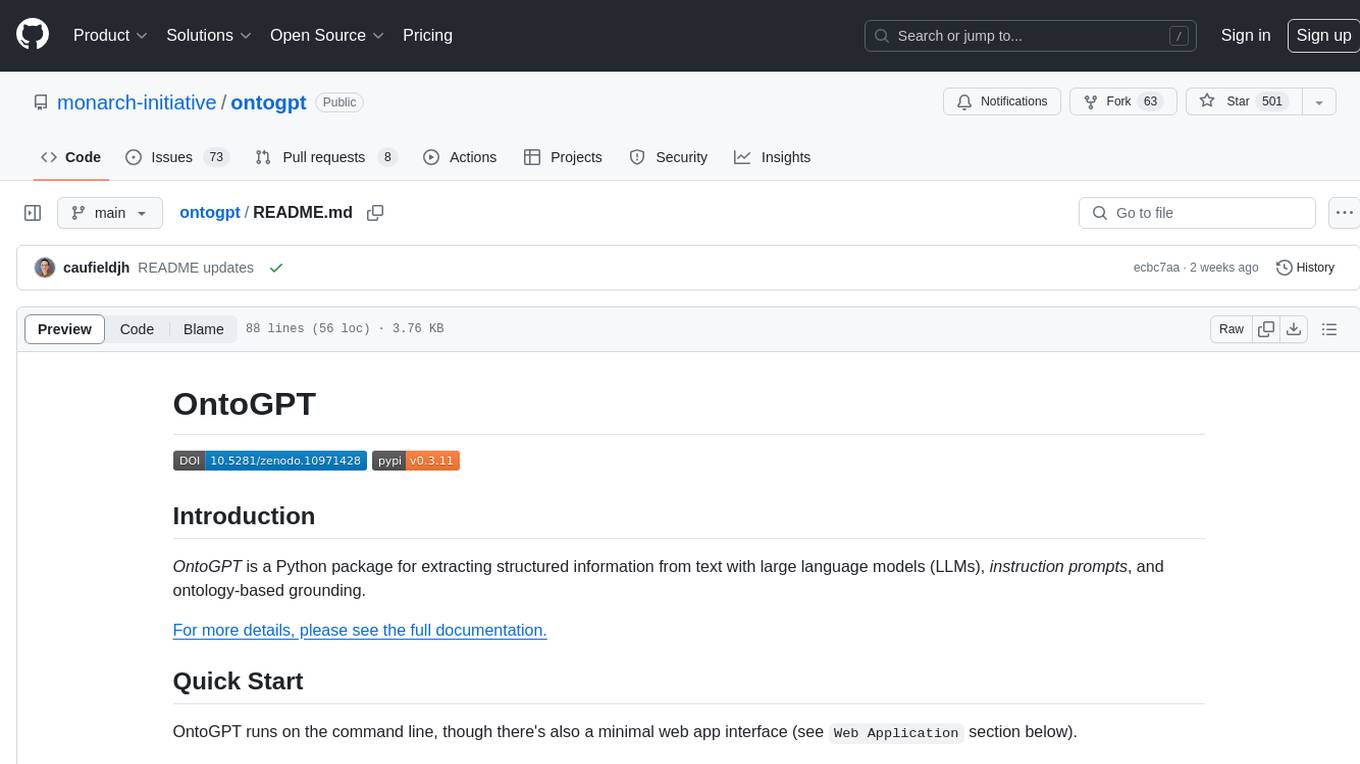
ontogpt
OntoGPT is a Python package for extracting structured information from text using large language models, instruction prompts, and ontology-based grounding. It provides a command line interface and a minimal web app for easy usage. The tool has been evaluated on test data and is used in related projects like TALISMAN for gene set analysis. OntoGPT enables users to extract information from text by specifying relevant terms and provides the extracted objects as output.
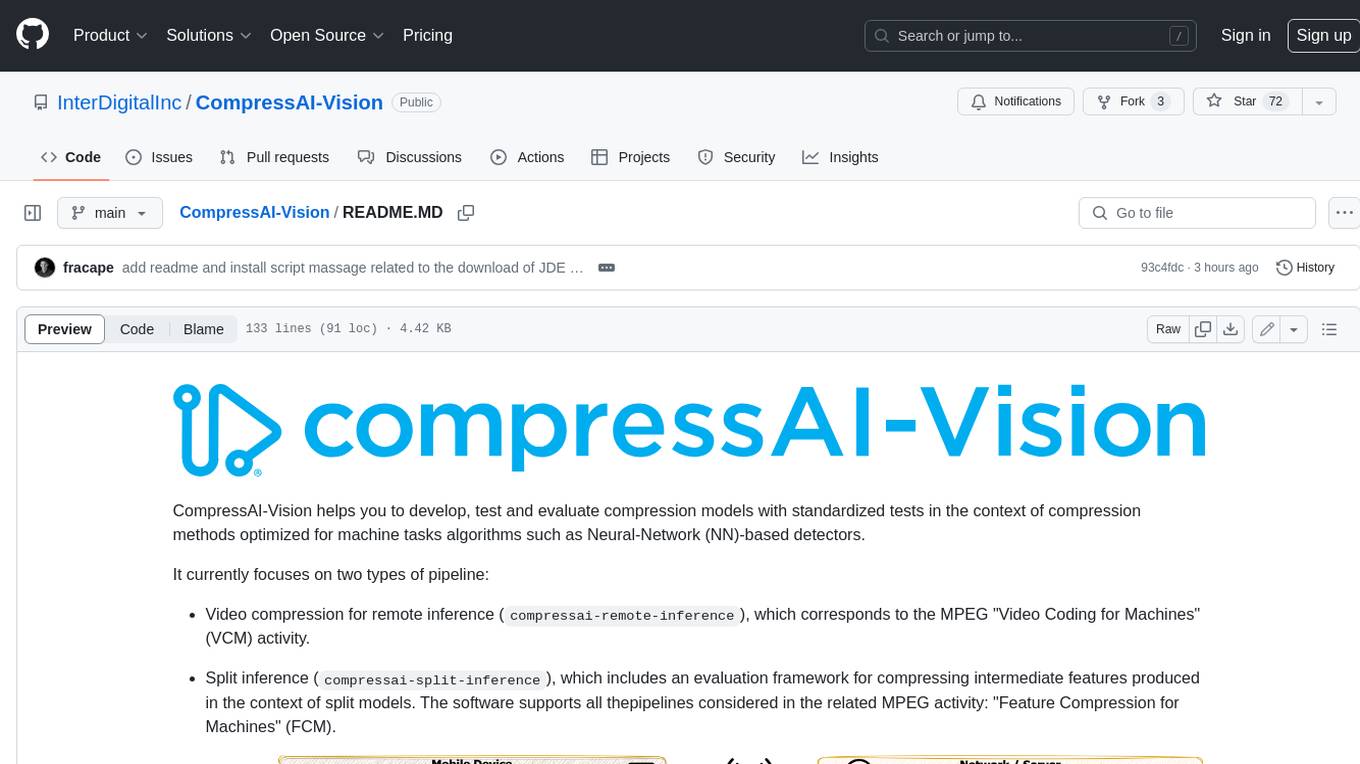
CompressAI-Vision
CompressAI-Vision is a tool that helps you develop, test, and evaluate compression models with standardized tests in the context of compression methods optimized for machine tasks algorithms such as Neural-Network (NN)-based detectors. It currently focuses on two types of pipeline: Video compression for remote inference (`compressai-remote-inference`), which corresponds to the MPEG "Video Coding for Machines" (VCM) activity. Split inference (`compressai-split-inference`), which includes an evaluation framework for compressing intermediate features produced in the context of split models. The software supports all the pipelines considered in the related MPEG activity: "Feature Compression for Machines" (FCM).

MegatronApp
MegatronApp is a toolchain built around the Megatron-LM training framework, offering performance tuning, slow-node detection, and training-process visualization. It includes modules like MegaScan for anomaly detection, MegaFBD for forward-backward decoupling, MegaDPP for dynamic pipeline planning, and MegaScope for visualization. The tool aims to enhance large-scale distributed training by providing valuable capabilities and insights.
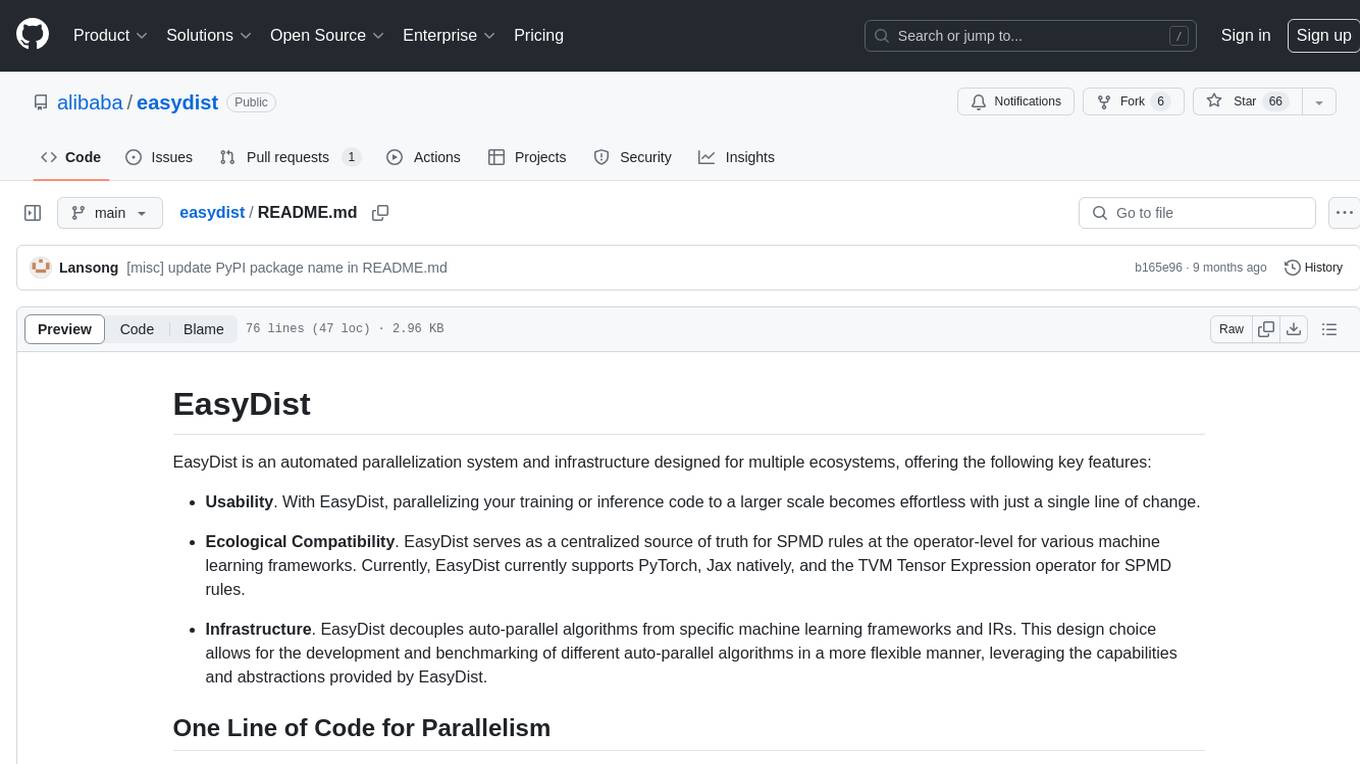
easydist
EasyDist is an automated parallelization system and infrastructure designed for multiple ecosystems. It offers usability by making parallelizing training or inference code effortless with just a single line of change. It ensures ecological compatibility by serving as a centralized source of truth for SPMD rules at the operator-level for various machine learning frameworks. EasyDist decouples auto-parallel algorithms from specific frameworks and IRs, allowing for the development and benchmarking of different auto-parallel algorithms in a flexible manner. The architecture includes MetaOp, MetaIR, and the ShardCombine Algorithm for SPMD sharding rules without manual annotations.
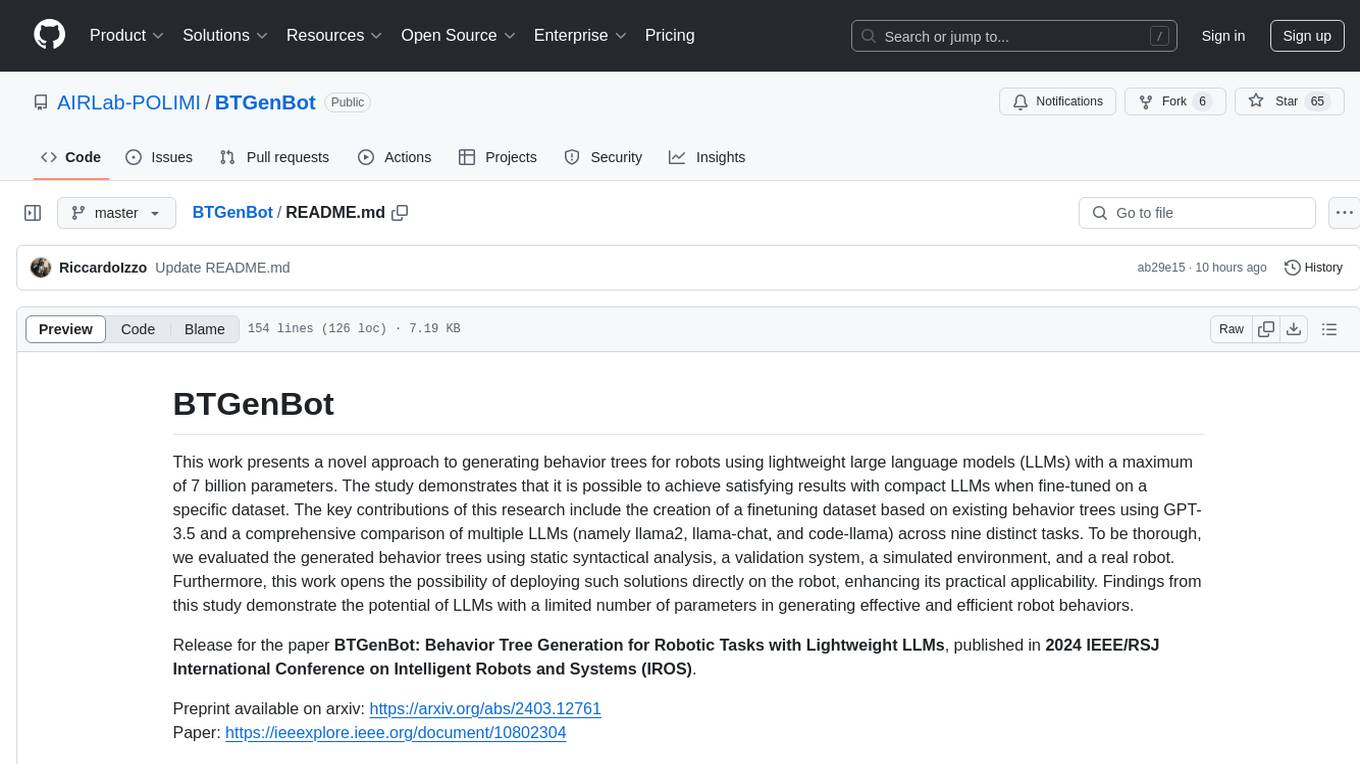
BTGenBot
BTGenBot is a tool that generates behavior trees for robots using lightweight large language models (LLMs) with a maximum of 7 billion parameters. It fine-tunes on a specific dataset, compares multiple LLMs, and evaluates generated behavior trees using various methods. The tool demonstrates the potential of LLMs with a limited number of parameters in creating effective and efficient robot behaviors.
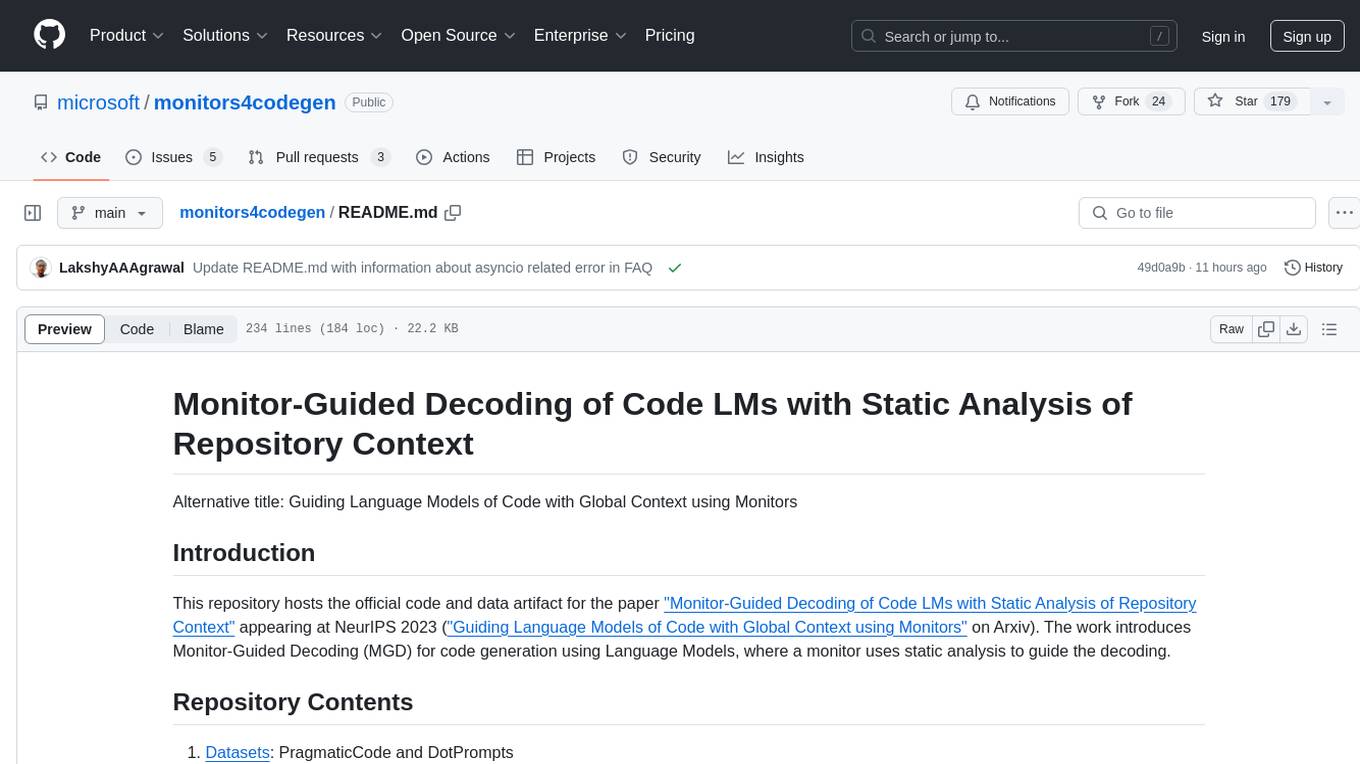
monitors4codegen
This repository hosts the official code and data artifact for the paper 'Monitor-Guided Decoding of Code LMs with Static Analysis of Repository Context'. It introduces Monitor-Guided Decoding (MGD) for code generation using Language Models, where a monitor uses static analysis to guide the decoding. The repository contains datasets, evaluation scripts, inference results, a language server client 'multilspy' for static analyses, and implementation of various monitors monitoring for different properties in 3 programming languages. The monitors guide Language Models to adhere to properties like valid identifier dereferences, correct number of arguments to method calls, typestate validity of method call sequences, and more.
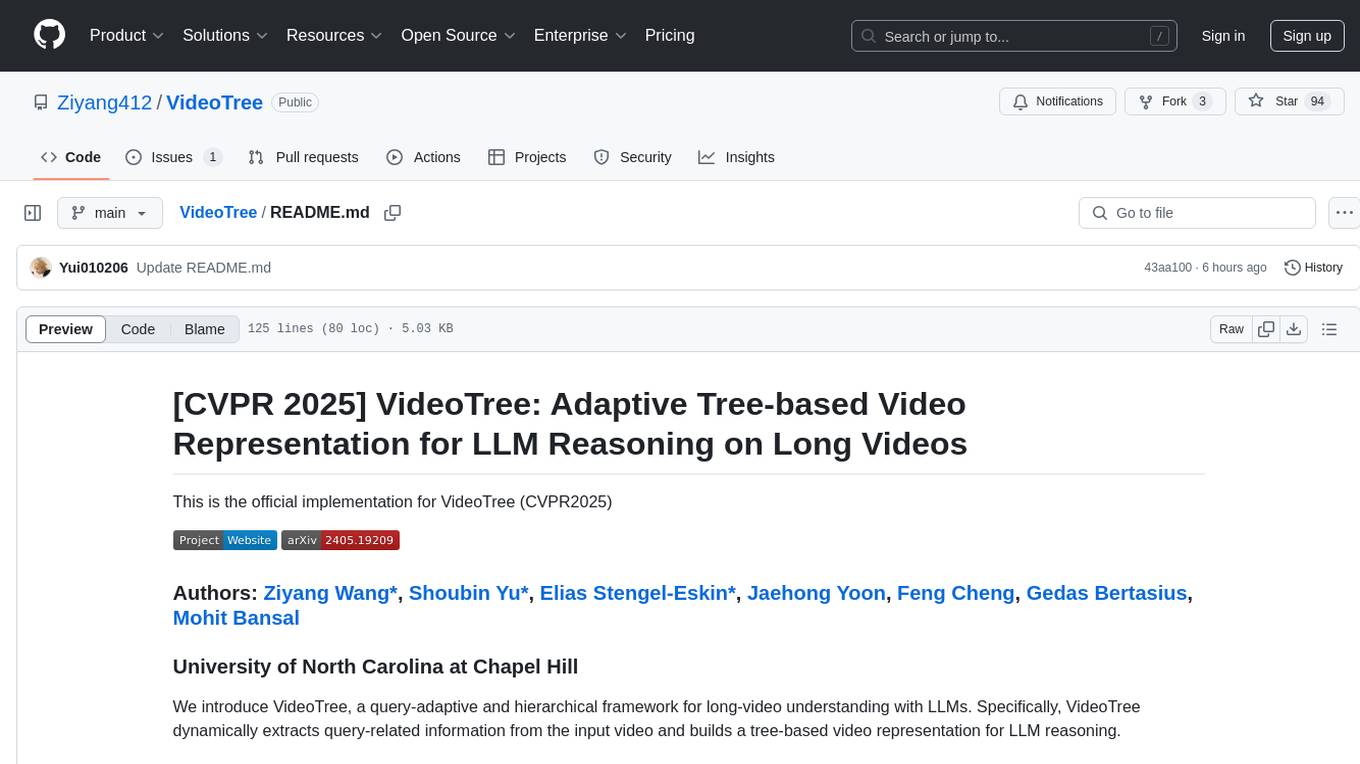
VideoTree
VideoTree is an official implementation for a query-adaptive and hierarchical framework for understanding long videos with LLMs. It dynamically extracts query-related information from input videos and builds a tree-based video representation for LLM reasoning. The tool requires Python 3.8 or above and leverages models like LaViLa and EVA-CLIP-8B for feature extraction. It also provides scripts for tasks like Adaptive Breath Expansion, Relevance-based Depth Expansion, and LLM Reasoning. The codebase is being updated to incorporate scripts/captions for NeXT-QA and IntentQA in the future.
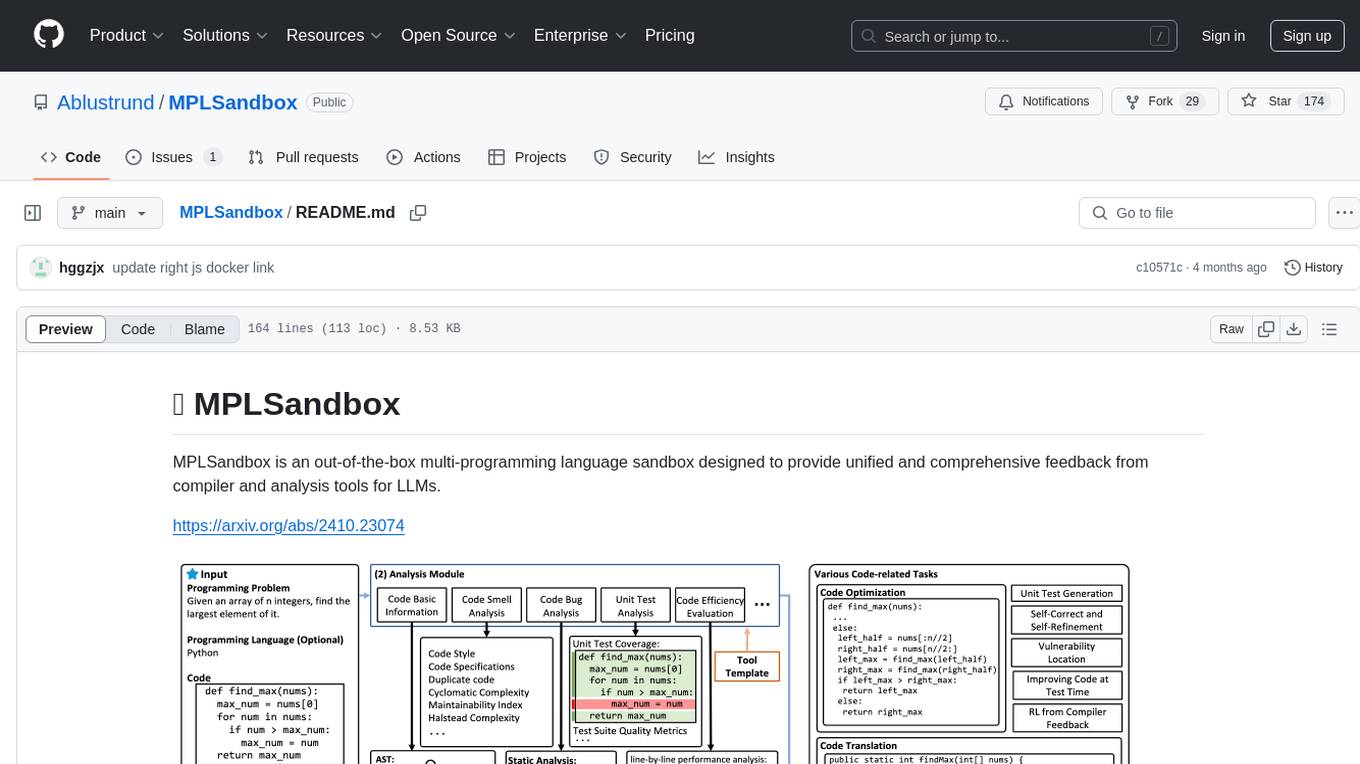
MPLSandbox
MPLSandbox is an out-of-the-box multi-programming language sandbox designed to provide unified and comprehensive feedback from compiler and analysis tools for LLMs. It simplifies code analysis for researchers and can be seamlessly integrated into LLM training and application processes to enhance performance in a range of code-related tasks. The sandbox environment ensures safe code execution, the code analysis module offers comprehensive analysis reports, and the information integration module combines compilation feedback and analysis results for complex code-related tasks.
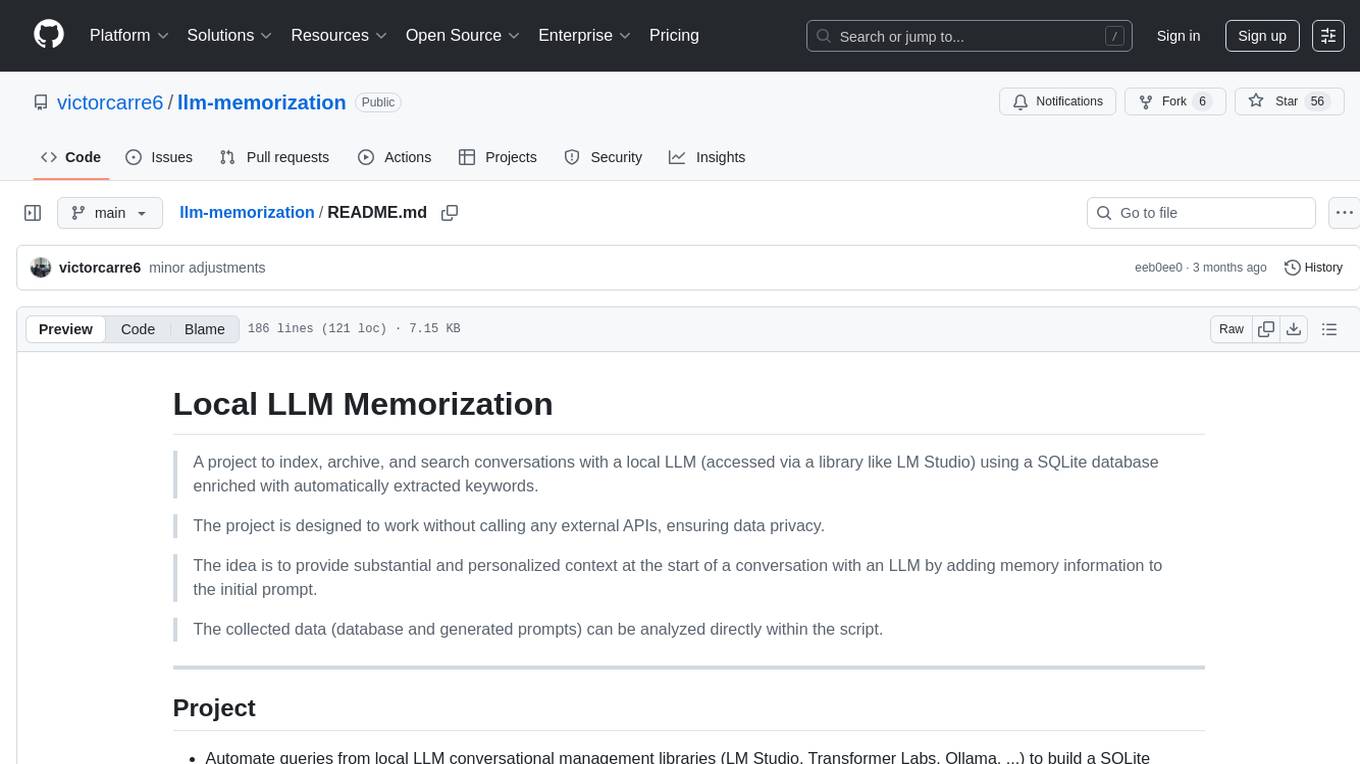
llm-memorization
The 'llm-memorization' project is a tool designed to index, archive, and search conversations with a local LLM using a SQLite database enriched with automatically extracted keywords. It aims to provide personalized context at the start of a conversation by adding memory information to the initial prompt. The tool automates queries from local LLM conversational management libraries, offers a hybrid search function, enhances prompts based on posed questions, and provides an all-in-one graphical user interface for data visualization. It supports both French and English conversations and prompts for bilingual use.
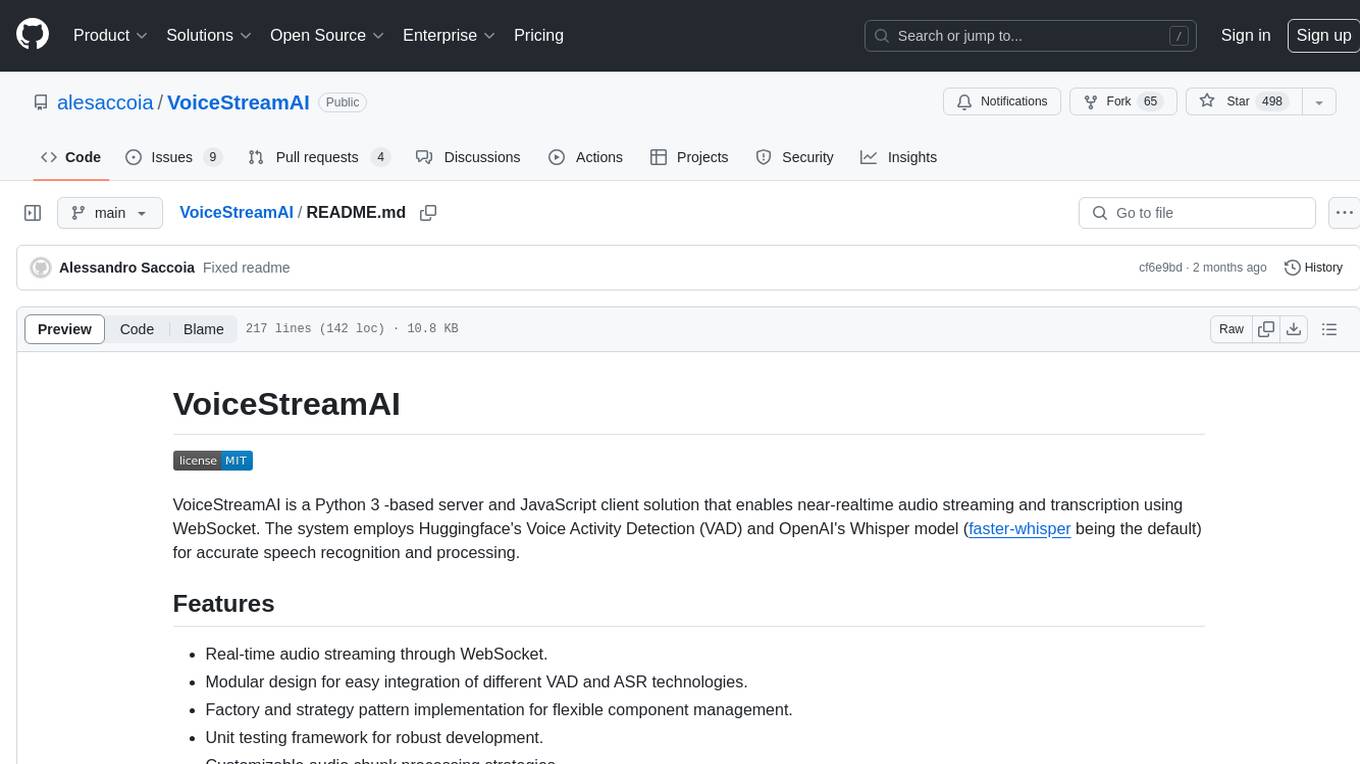
VoiceStreamAI
VoiceStreamAI is a Python 3-based server and JavaScript client solution for near-realtime audio streaming and transcription using WebSocket. It employs Huggingface's Voice Activity Detection (VAD) and OpenAI's Whisper model for accurate speech recognition. The system features real-time audio streaming, modular design for easy integration of VAD and ASR technologies, customizable audio chunk processing strategies, support for multilingual transcription, and secure sockets support. It uses a factory and strategy pattern implementation for flexible component management and provides a unit testing framework for robust development.
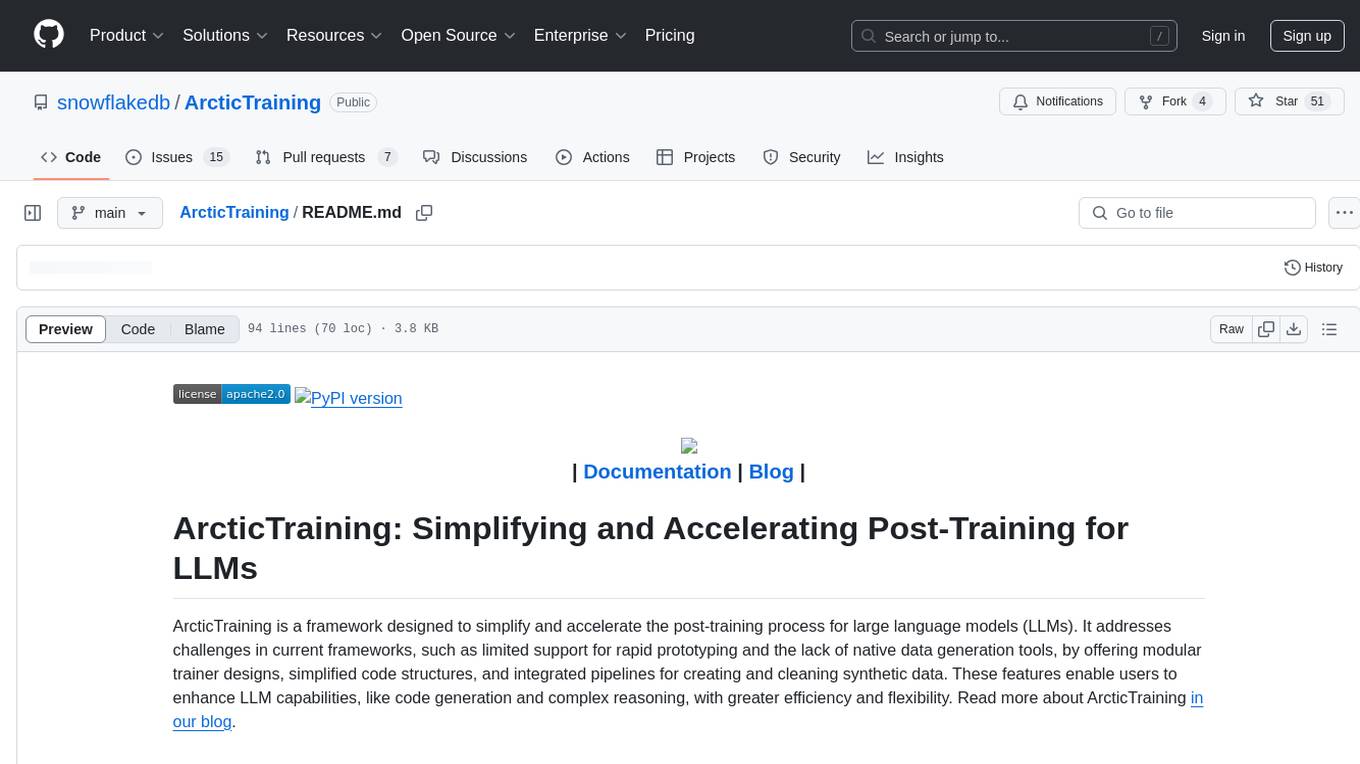
ArcticTraining
ArcticTraining is a framework designed to simplify and accelerate the post-training process for large language models (LLMs). It offers modular trainer designs, simplified code structures, and integrated pipelines for creating and cleaning synthetic data, enabling users to enhance LLM capabilities like code generation and complex reasoning with greater efficiency and flexibility.
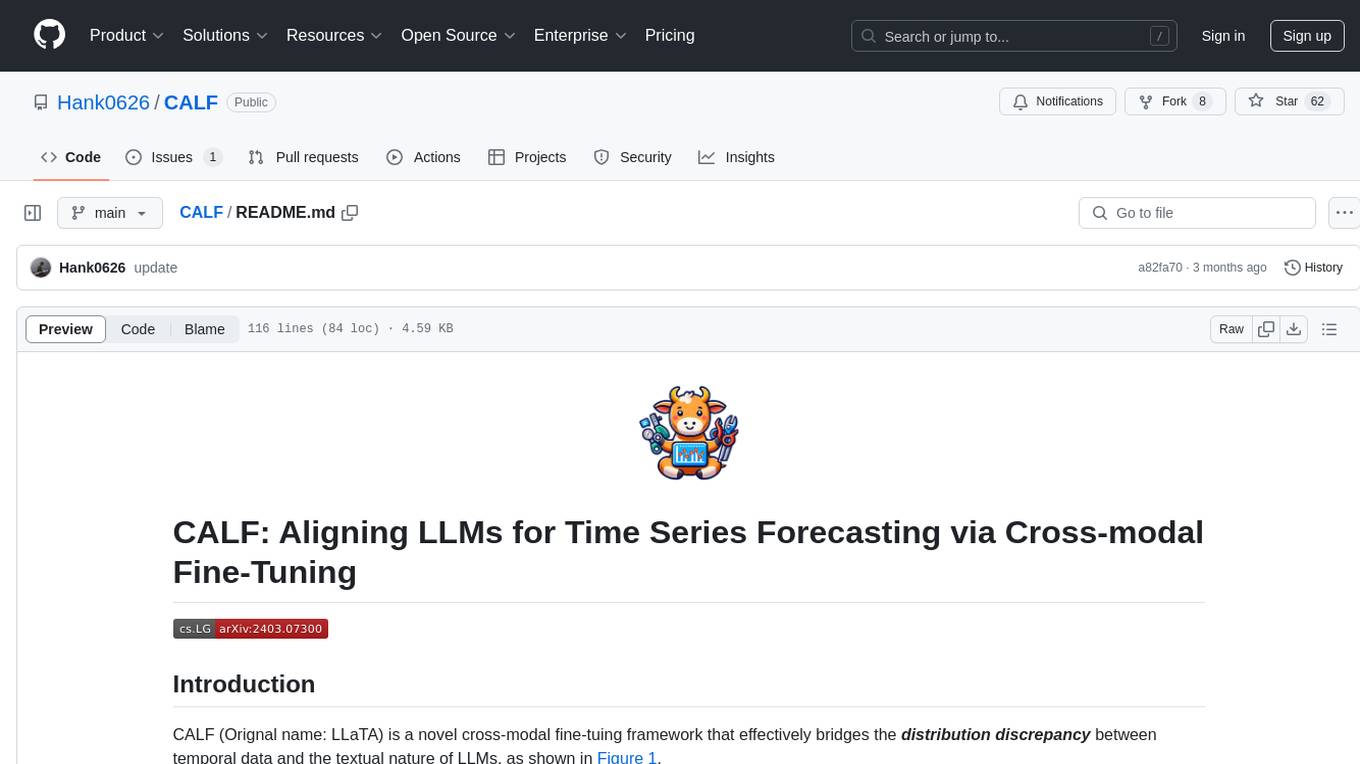
CALF
CALF (LLaTA) is a cross-modal fine-tuning framework that bridges the distribution discrepancy between temporal data and the textual nature of LLMs. It introduces three cross-modal fine-tuning techniques: Cross-Modal Match Module, Feature Regularization Loss, and Output Consistency Loss. The framework aligns time series and textual inputs, ensures effective weight updates, and maintains consistent semantic context for time series data. CALF provides scripts for long-term and short-term forecasting, requires Python 3.9, and utilizes word token embeddings for model training.
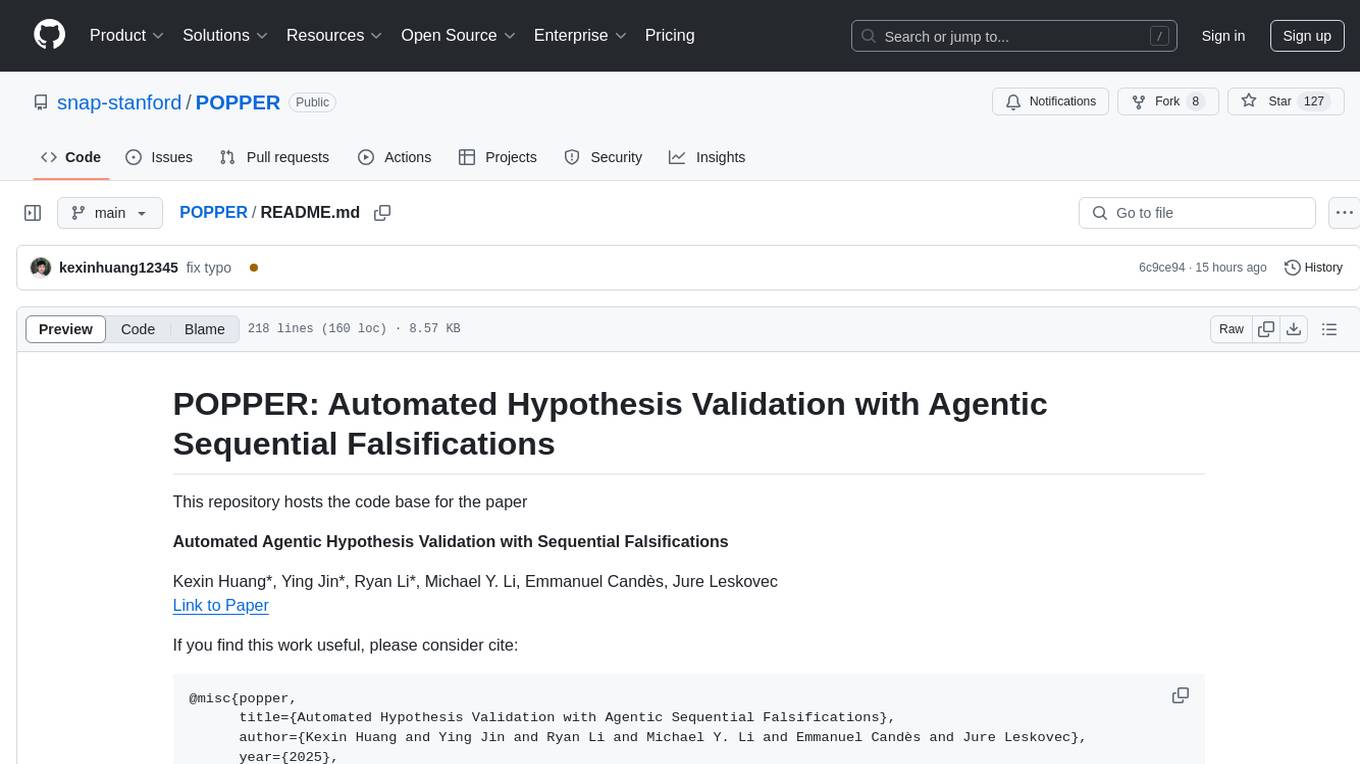
POPPER
Popper is an agentic framework for automated validation of free-form hypotheses using Large Language Models (LLMs). It follows Karl Popper's principle of falsification and designs falsification experiments to validate hypotheses. Popper ensures strict Type-I error control and actively gathers evidence from diverse observations. It delivers robust error control, high power, and scalability across various domains like biology, economics, and sociology. Compared to human scientists, Popper achieves comparable performance in validating complex biological hypotheses while reducing time by 10 folds, providing a scalable, rigorous solution for hypothesis validation.
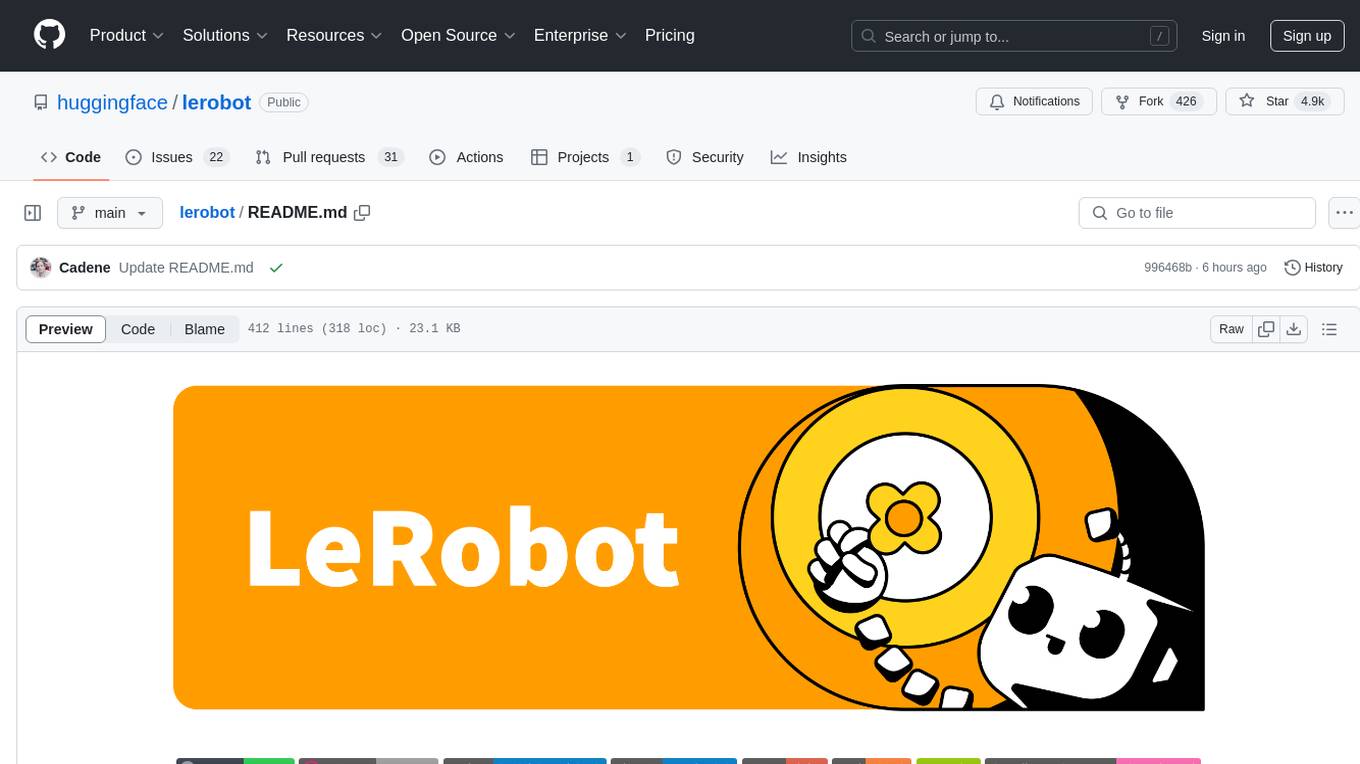
lerobot
LeRobot is a state-of-the-art AI library for real-world robotics in PyTorch. It aims to provide models, datasets, and tools to lower the barrier to entry to robotics, focusing on imitation learning and reinforcement learning. LeRobot offers pretrained models, datasets with human-collected demonstrations, and simulation environments. It plans to support real-world robotics on affordable and capable robots. The library hosts pretrained models and datasets on the Hugging Face community page.
For similar tasks

VSP-LLM
VSP-LLM (Visual Speech Processing incorporated with LLMs) is a novel framework that maximizes context modeling ability by leveraging the power of LLMs. It performs multi-tasks of visual speech recognition and translation, where given instructions control the task type. The input video is mapped to the input latent space of a LLM using a self-supervised visual speech model. To address redundant information in input frames, a deduplication method is employed using visual speech units. VSP-LLM utilizes Low Rank Adaptors (LoRA) for computationally efficient training.
For similar jobs

weave
Weave is a toolkit for developing Generative AI applications, built by Weights & Biases. With Weave, you can log and debug language model inputs, outputs, and traces; build rigorous, apples-to-apples evaluations for language model use cases; and organize all the information generated across the LLM workflow, from experimentation to evaluations to production. Weave aims to bring rigor, best-practices, and composability to the inherently experimental process of developing Generative AI software, without introducing cognitive overhead.

agentcloud
AgentCloud is an open-source platform that enables companies to build and deploy private LLM chat apps, empowering teams to securely interact with their data. It comprises three main components: Agent Backend, Webapp, and Vector Proxy. To run this project locally, clone the repository, install Docker, and start the services. The project is licensed under the GNU Affero General Public License, version 3 only. Contributions and feedback are welcome from the community.

oss-fuzz-gen
This framework generates fuzz targets for real-world `C`/`C++` projects with various Large Language Models (LLM) and benchmarks them via the `OSS-Fuzz` platform. It manages to successfully leverage LLMs to generate valid fuzz targets (which generate non-zero coverage increase) for 160 C/C++ projects. The maximum line coverage increase is 29% from the existing human-written targets.

LLMStack
LLMStack is a no-code platform for building generative AI agents, workflows, and chatbots. It allows users to connect their own data, internal tools, and GPT-powered models without any coding experience. LLMStack can be deployed to the cloud or on-premise and can be accessed via HTTP API or triggered from Slack or Discord.

VisionCraft
The VisionCraft API is a free API for using over 100 different AI models. From images to sound.

kaito
Kaito is an operator that automates the AI/ML inference model deployment in a Kubernetes cluster. It manages large model files using container images, avoids tuning deployment parameters to fit GPU hardware by providing preset configurations, auto-provisions GPU nodes based on model requirements, and hosts large model images in the public Microsoft Container Registry (MCR) if the license allows. Using Kaito, the workflow of onboarding large AI inference models in Kubernetes is largely simplified.

PyRIT
PyRIT is an open access automation framework designed to empower security professionals and ML engineers to red team foundation models and their applications. It automates AI Red Teaming tasks to allow operators to focus on more complicated and time-consuming tasks and can also identify security harms such as misuse (e.g., malware generation, jailbreaking), and privacy harms (e.g., identity theft). The goal is to allow researchers to have a baseline of how well their model and entire inference pipeline is doing against different harm categories and to be able to compare that baseline to future iterations of their model. This allows them to have empirical data on how well their model is doing today, and detect any degradation of performance based on future improvements.

Azure-Analytics-and-AI-Engagement
The Azure-Analytics-and-AI-Engagement repository provides packaged Industry Scenario DREAM Demos with ARM templates (Containing a demo web application, Power BI reports, Synapse resources, AML Notebooks etc.) that can be deployed in a customer’s subscription using the CAPE tool within a matter of few hours. Partners can also deploy DREAM Demos in their own subscriptions using DPoC.
